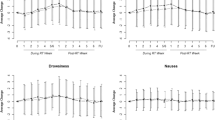Abstract
Background and purpose
Patients undergoing radiotherapy (RT) for breast cancer may receive adjuvant or neoadjuvant chemotherapy prior to the initiation of RT treatment. In the present study, baseline Edmonton Symptom Assessment System (ESAS) scores of patients who received neoadjuvant and adjuvant chemotherapy were collected prior to RT and compared to assess the association of each chemotherapy intent with pre-RT symptom burden.
Material and methods
The ESAS and Patient-Reported Functional Status (PRFS) tools were used to collect patient-reported symptoms at baseline. Patient and treatment-related factors were collected prospectively from February 2018 to September 2020. Univariate general linear regression analysis was applied to compare baseline scores between adjuvant and neoadjuvant chemotherapy patients.
Results
A total of 338 patients were included for analysis. Comparison of baseline ESAS scores revealed that patients who received adjuvant chemotherapy were more likely to report higher scores, reflecting higher symptom burden, compared to patients receiving neoadjuvant chemotherapy, including tiredness (p = 0.005), lack of appetite (p = 0.0005), shortness of breath (p < 0.0001), and PRFS (p = 0.012).
Conclusion
This study suggests an association between patients who have received adjuvant chemotherapy for breast cancer and higher RT baseline ESAS scores when compared to patients who received neoadjuvant chemotherapy. Due to these findings, considerations should be made by healthcare providers of the symptom burden during RT for patients who receive adjuvant chemotherapy.

Similar content being viewed by others
Data availability
The data that support the findings of this study are available from the corresponding author (E.C) upon reasonable request.
References
“Breast Cancer Statistics | How Common Is Breast Cancer?” https://www.cancer.org/cancer/breast-cancer/about/how-common-is-breast-cancer.html (accessed Apr. 23, 2022).
Waks AG, Winer EP (2019) Breast Cancer Treatment: A Review. JAMA 321(3):288–300. https://doi.org/10.1001/jama.2018.19323
Montemurro F, Nuzzolese I, Ponzone R (2020) Neoadjuvant or adjuvant chemotherapy in early breast cancer? Expert Opin Pharmacother 21(9):1071–1082. https://doi.org/10.1080/14656566.2020.1746273
Masood S (2016) Neoadjuvant chemotherapy in breast cancers. Womens Health 12(5):480–491. https://doi.org/10.1177/1745505716677139
Prieto-Callejero B et al (2020) Relationship between chemotherapy-induced adverse reactions and health-related quality of life in patients with breast cancer. Medicine (Baltimore) 99(33):e21695. https://doi.org/10.1097/MD.0000000000021695
Hamer J et al (2017) Quality of life (QOL) and symptom burden (SB) in patients with breast cancer. Support Care Cancer 25(2):409–419. https://doi.org/10.1007/s00520-016-3417-6
Dilalla V, Chaput G, Williams T, Sultanem K (2020) Radiotherapy Side Effects: Integrating a Survivorship Clinical Lens to Better Serve Patients. Curr Oncol 27(2):107–112. https://doi.org/10.3747/co.27.6233
Hui D, Bruera E (2017) The Edmonton Symptom Assessment System 25 Years Later: Past, Present, and Future Developments. J Pain Symptom Manage 53(3):630–643. https://doi.org/10.1016/j.jpainsymman.2016.10.370
Silva SB et al (2018) Clinical impact of adjuvant radiation therapy delay after neoadjuvant chemotherapy in locally advanced breast cancer. Breast 38:39–44. https://doi.org/10.1016/j.breast.2017.11.012
Suleman K et al (2020) Does the Timing of Surgery after Neoadjuvant Therapy in Breast Cancer Patients Affect the Outcome? Oncology 98(3):168–173. https://doi.org/10.1159/000504964
Cao L et al (2021) How Does the Interval Between Completion of Adjuvant Chemotherapy and Initiation of Radiotherapy Impact Clinical Outcomes in Operable Breast Cancer Patients? Ann Surg Oncol 28(4):2155–2168. https://doi.org/10.1245/s10434-020-09026-z
Ataseven B et al (2020) Perception of side effects associated with anticancer treatment in women with breast or ovarian cancer (KEM-GO-1): a prospective trial. Support Care Cancer 28(8):3605–3615. https://doi.org/10.1007/s00520-019-05216-y
Nies YH, Ali AM, Abdullah N, Islahudin F, Shah NM (2018) A qualitative study among breast cancer patients on chemotherapy: experiences and side-effects. Patient Prefer Adherence 12:1955–1964. https://doi.org/10.2147/PPA.S168638
Wagner JF, Lüdders D, Hoellen F, Rody A, Banz-Jansen C (2019) Treatment anxiety in breast cancer patients. Arch Gynecol Obstet 299(5):1365–1371. https://doi.org/10.1007/s00404-018-05038-z
Funding
The authors declare that no funds, grants, or other support were received during the preparation of this manuscript.
Author information
Authors and Affiliations
Contributions
Edward Chow and Irene Karam contributed to the design of the study. Lauren Milton, Tara Behroozian, Emily Lam, and Gina Wong contributed to data collection. Julia Lou and Liying Zhang contributed to data analysis and preparation of tables. Shereen Akkila and Saba Shariati contributed equally to the writing of this manuscript and are joint primary authors. All authors have reviewed and approved the contents of the manuscript.
Corresponding author
Ethics declarations
Competing interests
The authors have no relevant financial or non-financial interests to disclose.
Ethics approval
Approval for this study was granted by Sunnybrook Health Science Centre’s Research Ethics Board.
Consent to participate
Informed consent was obtained from all individual participants included in the study.
Additional information
Publisher's note
Springer Nature remains neutral with regard to jurisdictional claims in published maps and institutional affiliations.
Shereen Akkila and Saba Shariati are joint first authors.
Supplementary Information
Below is the link to the electronic supplementary material.
Rights and permissions
Springer Nature or its licensor (e.g. a society or other partner) holds exclusive rights to this article under a publishing agreement with the author(s) or other rightsholder(s); author self-archiving of the accepted manuscript version of this article is solely governed by the terms of such publishing agreement and applicable law.
About this article
Cite this article
Akkila, S., Shariati, S., Milton, L. et al. Comparison of neoadjuvant versus adjuvant chemotherapy for breast cancer patients prior to receiving radiation therapy using Edmonton Symptom assessment system (ESAS) scores. Support Care Cancer 31, 236 (2023). https://doi.org/10.1007/s00520-023-07700-y
Received:
Accepted:
Published:
DOI: https://doi.org/10.1007/s00520-023-07700-y



